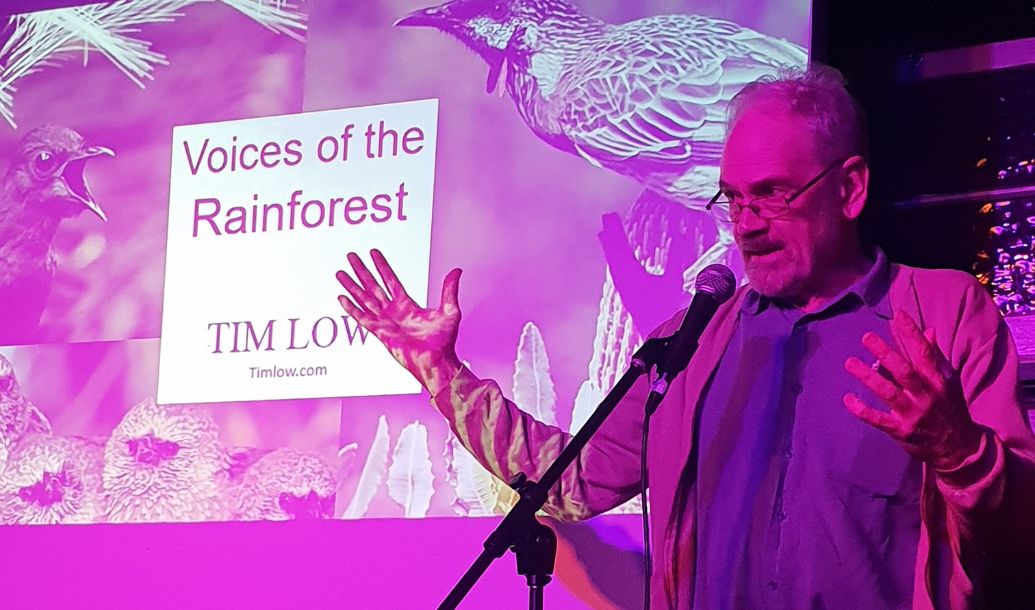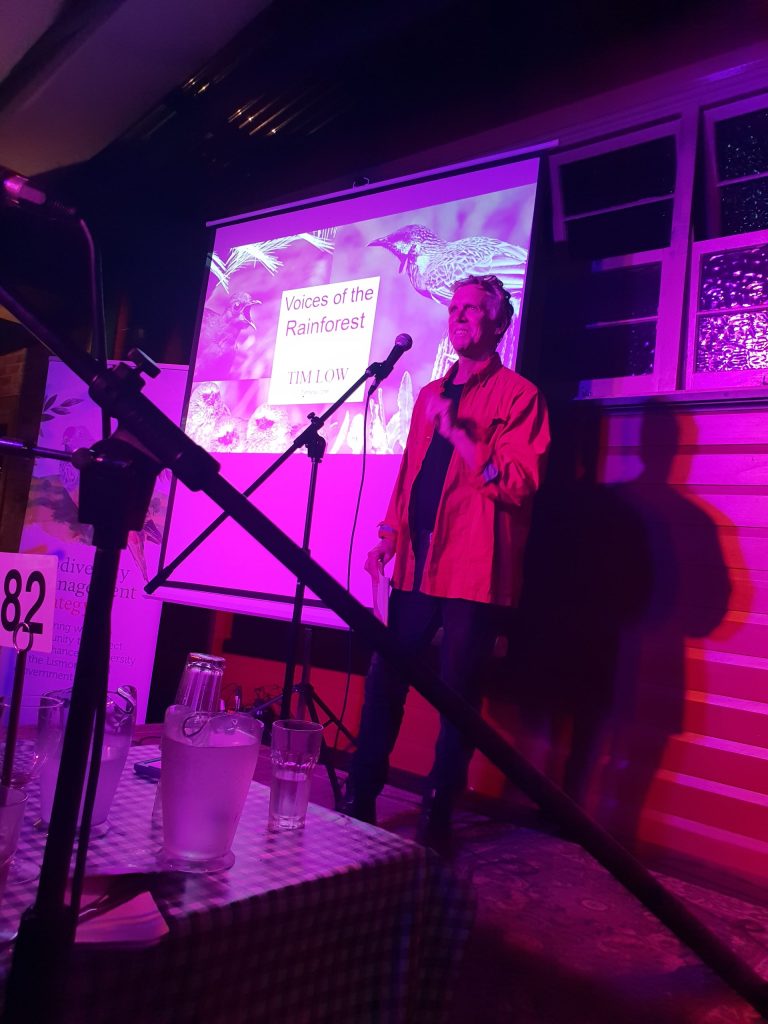The long awaited – two years in the making – Science in the Pub with Tim Low finally took place last week at the Eltham Hotel.
After being delayed by Covid and the floods, Lismore City Council, Richmond Landcare Inc and the other presenting partners staged the event in front of over 100 attendees, who were treated to Tim’s fascinating insights into the evolution of bird song and bird communities.
Our Vice President and Co-Founder Mark Dunphy warmed the crowd up for Tim with his observations about how European settlement had impacted bird populations in the area.
When the horrific clearing of the Big Scrub took place, there were winners and losers among the different bird communities. The black and white species from the open woodland – like crows, currawongs, mudlarks, butcherbirds, as well as kookaburras and some raptors – were able to expand their territory, while species like riflebirds, fruit doves and lyrebird retreated to the mountains and deep valleys.
However another transformation took place in the last 30 years or so as introduced and native species gained a foothold across fields and in gullies, and in the gardens of new settlers to the area.
Mark spoke about three main influence on bird populations:
1. Camphor laurel
“The camphor laurel that have proliferated around the landscape have become a huge food source for so many birds but most dramatically flock or top-knot pigeon. They used to be rarely seen, but are now common in huge whirling flocks, feeding in the hundreds of thousands of fruiting camphors, which can each produce up to 100,000 fruit.
The top knots drop thousands of seeds across the landscape on their way to roost in the eucalypts around the region. Have you noticed more are starting to hang around in the area in the off season instead of heading back up to the mountains, possibly because there is more food locally keeping them here out of season.
One day people may come to the world famous top-knot pigeon festival where we celebrate the arrival of the massive flocks of top-knots feeding on the great camphor laurel forest of Northern NSW.”
2. Returning rainforest
“The second critical change for birds has been the natural and assisted regeneration of forest and the planting of trees in the region.
Big Scrub Rainforest Conservancy estimates over 3 million rainforest trees have been planted and hundreds of hectares established and regenerated from remnants and fragments. That’s a lot of food and habitat for birds. Think of all the millions of small fruits of the pioneers like bleeding hearts and brown kurrajongs, think of all the secondaries planted like kamalas, euodias, guoias and the mature phase laurels, figs and lilly pillys.
From basically a bare paddock from Lismore to Ballina, Byron and Mullum, we have some excellent forest and reasonable cover with macadamia plantations, camphor, privet for rainforest birds to come back. Brush turkeys, Luewin honey eaters, yellow robins and whip birds were early movers in this environment. But now wompoo pigeons, rose crowned and purple crowned pigeons are more common as the laurels and lily pillys and particularly bangalow palms fruit heavily.
But what about riflebirds, alberts lyrebirds? We’re looking forward to seeing these birds return.”
3. Gardens
“If you have read Tims book New Nature you will know many birds love the food and protection
From one huge bare paddock a huge variety of habitat and food fruiting all year around – grevilleas, callistemons, banksias , rainforest trees and exotic plants – the birds love it.
I have white-headed pigeons constantly courting and nesting as close to the house as they can get. Blue wrens and red-browed finches cleaning up the crumbs on the verandah. The marauding gangs of yellow tailed black cockatoos destroy my pink ash and hang out in my banksias like overgrown teenagers. The satin bowerbirds come in winter and graze on the lawn like cows while the males make bowers as close to my house as possible enticing a conga line of females through the blue theme park.
The noisy miners battle it out with blue-faced honeyeaters, not so little wattlebird and friarbirds, and even the exotic indian mynas can’t get a foothold, the competition is so strong. King parrots that were rarely seen are now a constant eating all the Davidson plum seed, and have now discovered the red bopple nuts and winter fruiting Queensland Davidson plums.
I saw more species of birds in my garden in a week than I saw in a month in Borneo.”
Tim’s speech following Mark’s was an in-depth and fascinating look at bird populations, derived from his decades of studying bird behaviour across the globe. He spoke about the importance of Australia to the study of birdlife, pinpointing our region as the epicentre of birdsong evolution and the lyrebird, identified in fossils dating back 20 million years, as the world’s best songbird.
The night concluded with a panel discussion between Tim, Mark and Wendy Neilan, Principal Ecologist at the Biodiversity Conservation Trust.
The event left us with a message for the future: As climate change increases and extreme weather events contribute to biodiversity loss, it’s important to create as much varied habitat and food sources as possible to keep our birds alive and thriving.






